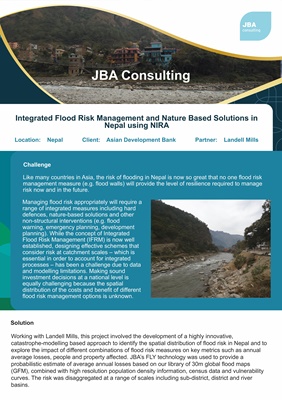
JBA Consulting
Managing flood risk appropriately will require a
range of integrated measures including hard
defences, nature-based solutions and other
non-structural interventions (e.g. flood
warning, emergency planning, development
planning). While the concept of Integrated
Flood Risk Management (IFRM) is now well
established, designing effective schemes that
consider risk at catchment scales - which is
essential in order to account for integrated
processes - has been a challenge due to data
and modelling limitations. Making sound
investment decisions at a national level is
equally challenging because the spatial
distribution of the costs and benefit of different
flood risk management options is unknown.
Challenge
Integrated Flood Risk Management and Nature Based Solutions in
Nepal using NIRA
Location: Nepal Client: Asian Development Bank Partner: Landell Mills
Solution
Working with Landell Mills, this project involved the development of a highly innovative,
catastrophe-modelling based approach to identify the spatial distribution of flood risk in Nepal and to
explore the impact of different combinations of flood risk measures on key metrics such as annual
average losses, people and property affected. JBA's FLY technology was used to provide a
probabilistic estimate of average annual losses based on our library of 30m global flood maps
(GFM), combined with high resolution population density information, census data and vulnerability
curves. The risk was disaggregated at a range of scales including sub-district, district and river
basins.
Like many countries in Asia, the risk of flooding in Nepal is now so great that no one flood risk
management measure (e.g. flood walls) will provide the level of resilience required to manage
risk now and in the future.